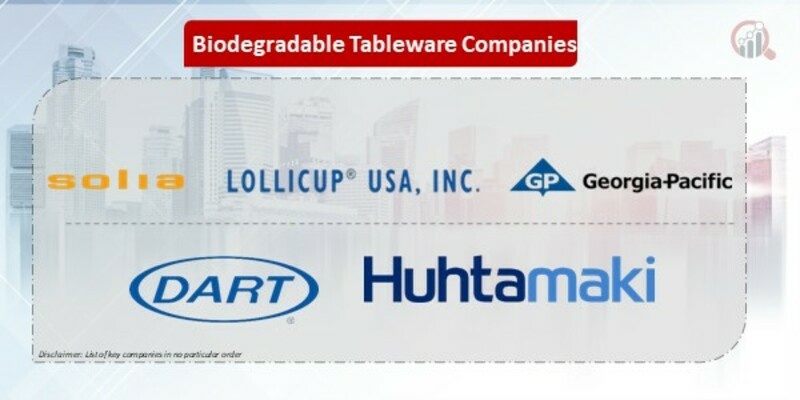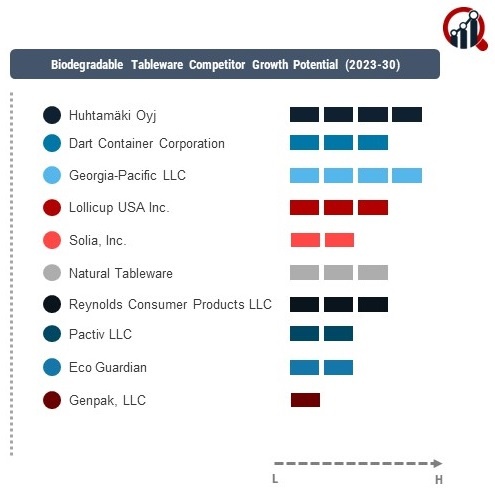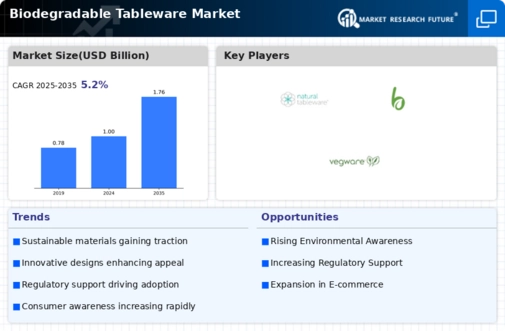Top Industry Leaders in the Biodegradable Tableware Market
 The competitive landscape of the biodegradable tableware market is witnessing significant activity as consumer preferences shift towards sustainable alternatives. As of 2023, a set of key players dominates this sector, employing diverse strategies to establish their presence and gain market share.
The competitive landscape of the biodegradable tableware market is witnessing significant activity as consumer preferences shift towards sustainable alternatives. As of 2023, a set of key players dominates this sector, employing diverse strategies to establish their presence and gain market share.
Key Players:
Pactiv LLC (US)
Huhtamäki Oyj (Finland)
Dart Container Corporation (US)
Georgia-Pacific LLC (US)
Lollicup USA Inc. (US)
Solia, Inc. (US)
Natural Tableware (Netherlands)
Biotrem (Poland)
Reynolds Consumer Products LLC (US)
Genpak, LLC (US)
Vegware (UK)
Papstar GmbH (Germany)
Bionatic GmbH & Co. KG (Germany)
Better Earth LLC (US)
Eco Guardian (Canada)
Strategies Adopted:
Strategies adopted by these key players typically revolve around innovation in materials, product design, and manufacturing processes. Eco-Products Inc., for instance, has been a frontrunner in introducing biodegradable alternatives made from renewable resources such as sugarcane and cornstarch. Biopac India Corporation Ltd. focuses on expanding its product range while maintaining strict adherence to compostability standards. Biotrem has differentiated itself by offering tableware made from wheat bran, providing a unique and eco-friendly option. Vegware emphasizes design and functionality, creating biodegradable tableware that meets both aesthetic and environmental criteria. World Centric adopts a holistic approach by incorporating fair trade practices into its supply chain, appealing to consumers seeking ethical choices.
Market Share Analysis:
The biodegradable tableware market is influenced by factors such as product quality, pricing, distribution efficiency, and adherence to sustainability standards. Companies that excel in producing durable, functional, and cost-competitive biodegradable tableware while maintaining a commitment to eco-friendly practices tend to secure a larger market share. Additionally, partnerships with foodservice providers, restaurants, and retailers play a crucial role in expanding market reach, allowing companies to establish themselves as preferred suppliers in the biodegradable tableware segment.
News & Emerging Companies:
The biodegradable tableware market have been making headlines in 2023, capitalizing on the growing demand for sustainable alternatives to traditional tableware. Startups like GreenWare and Leaf & Fiber have entered the market with innovative products, often targeting specific niche markets or introducing unique material compositions. While the market share of these emerging companies may be relatively modest at present, their ability to adapt quickly and cater to evolving consumer preferences poses a potential challenge to established players.
Industry Trends:
Industry trends highlight the continued momentum toward sustainable practices within the biodegradable tableware market. Companies are increasingly investing in research and development to improve the performance and appearance of biodegradable tableware, making it a more attractive option for consumers. Additionally, investments in efficient manufacturing processes and technology contribute to cost-effectiveness, allowing companies to offer competitive pricing.
Competitive Scenario:
The biodegradable tableware market reflects a balance between established players and emerging competitors. Key players maintain their stronghold through brand reputation, product innovation, and strategic partnerships, while emerging companies disrupt the market by introducing fresh perspectives and unique offerings. The competition is further intensified by the entry of mainstream packaging and disposable tableware companies, which are expanding their portfolios to include biodegradable options to meet the demand for sustainable alternatives.
Recent Development
The biodegradable tableware market is characterized by a mix of established players, emerging companies, and a shared commitment to sustainability. Key players maintain their market presence through product quality, innovation, and strategic collaborations, while emerging companies introduce diversity and innovation. As the industry continues to evolve, investments in research and development, efficient manufacturing processes, and advancements in material technology will likely shape the competitive dynamics of the biodegradable tableware market. Companies that can navigate these factors and align with the growing demand for sustainable solutions are poised for success in this dynamic and environmentally conscious marketplace.










